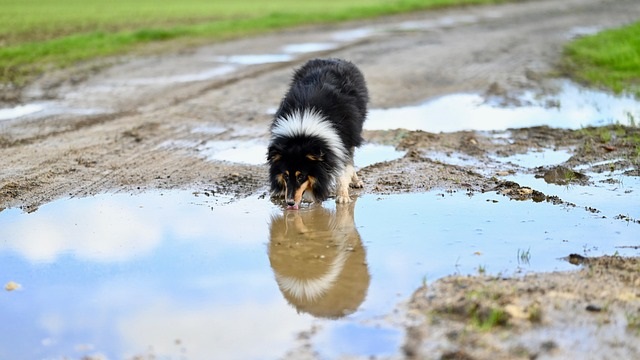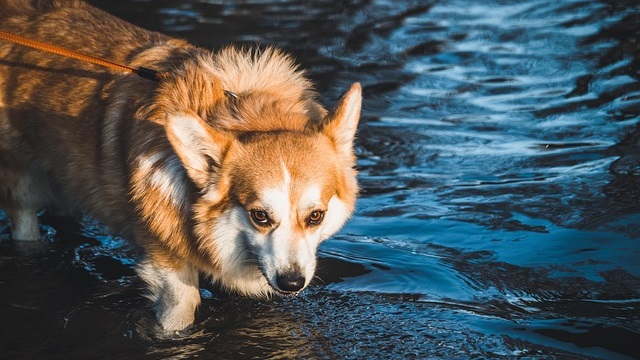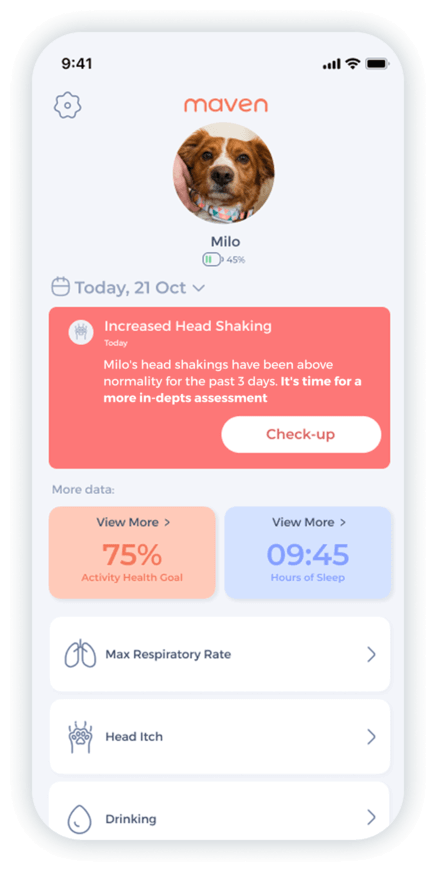Dog Drinking a Lot of Water: Signs of Diabetes or Kidney Issues?
Noticing your dog constantly at their water bowl, or needing frequent potty breaks, can be a source of worry, and it’s natural to ask yourself, “why is my dog drinking so much water?”
While a high-thirst day after a long run in the park is normal, a persistent increase in water intake—medically known as polydipsia—is often an important clue about your dog’s health.
Understanding the difference between a normal variation and a potential red flag is the first step toward getting their dog the right care.
This guide will help you understand what’s normal, what’s not, and when it’s time to call the vet.
Key Takeaways

- Excessive thirst in dogs (polydipsia) is a common symptom that can signal an underlying health issue.
- The normal daily water intake for a dog is about 1 ounce per pound of body weight. Any significant increase beyond this range should be monitored.
- While some causes are harmless (like hot weather or intense exercise), others, such as kidney disease, diabetes, or Cushing’s disease, require immediate veterinary attention.
- Tracking your dog’s water intake over time provides a crucial baseline, helping you spot gradual changes that might otherwise go unnoticed.
How Much Water Should a Dog Drink Daily?
A good rule of thumb, according to experts, is that a dog should drink approximately 1 ounce of water per pound of body weight per day. For example, a 50-pound dog would typically drink about 50 ounces (around 6.25 cups) of water daily.
Keep in mind that this is just an average. Several factors can influence a dog’s daily water consumption, including:
- Diet: Dogs on a dry kibble diet will drink more than those on a wet food diet, which has a higher moisture content.
- Exercise Level: An active dog will need significantly more water to stay hydrated.
- Weather: During hot weather, a dog’s need for water can increase dramatically.
- Age and Size: Puppies and large-breed dogs may have different hydration needs.
The key isn’t to obsess over a specific number, but rather to establish what is “normal” for your individual dog and then be alert to any significant changes.
“I got the Maven sensor for my 14-year-old Chihuahua mix with heart and trachea issues. It gave me back peace of mind – I can track her RRR, BPM, drinking, and activity anytime and know instantly if something’s wrong. Highly recommend!”

★★★★★
Chiara De Luca
Titti
Why Is My Dog Drinking So Much Water?
If you’ve ruled out obvious causes like a hot day or a recent long walk, a noticeable increase in water intake may point to an underlying issue. The causes can range from benign to serious.
Some of the most common reasons for a dog drinking a lot of water include:
- Increased Exercise: A more intense-than-usual play session can make any dog thirsty.
- Changes in Diet: A switch to a new, saltier food or an increase in dry food can cause your dog to drink more.
- Certain Medications: Some common medications, such as corticosteroids, can cause increased thirst as a side effect.
- Recent Stress: Stress or anxiety can sometimes lead to an increase in drinking.
My Dog Is Drinking a Lot of Water: Should I Be Worried?

If the excessive drinking is new and persistent—lasting for more than a day or two—it’s a sign that something might be amiss. You should be especially concerned if you also notice other symptoms.
Red flags that your dog’s excessive thirst may be a serious issue include:
- Increased Urination: You’re refilling the water bowl and letting them out to pee far more often than usual.
- Loss of Appetite: They are drinking a lot but not eating much.
- Weight Loss: Unexplained weight loss, especially when paired with a big appetite, is a major warning sign.
- Lethargy: Your dog seems unusually tired or less energetic.
- Vomiting or Diarrhea: These symptoms, especially when combined with high thirst, can indicate a serious problem.
What Conditions are Linked to Excessive Thirst
When a vet investigates why a dog is drinking so much water, they are often looking to rule out a handful of serious health conditions. Many of these conditions have polydipsia as an early, key symptom.
- Diabetes Mellitus: One of the most common causes of excessive thirst and urination. When the body can’t properly use glucose, it spills into the urine, pulling water with it and causing dehydration.
- Kidney Disease: The kidneys are responsible for filtering waste and conserving water. When they fail, they lose the ability to concentrate urine, leading to increased thirst and frequent urination.
- Cushing’s Disease (Hyperadrenocorticism): This hormonal disorder causes the body to produce too much cortisol. Symptoms include excessive thirst, increased appetite, and a pot-bellied appearance.
- Liver Disease: Problems with the liver can disrupt its ability to produce certain hormones, leading to an increase in thirst.
- Urinary Tract Infections (UTIs): These can cause a dog to feel the constant need to urinate, which in turn makes them drink more water.
When Should You Call the Vet?

If you’ve noticed a persistent change in your dog’s drinking habits, especially if you see any of the red flag symptoms listed above, it’s time to schedule a veterinary appointment. Early diagnosis is key for many of these conditions. Be prepared to tell your vet exactly how much your dog is drinking, how often they are urinating, and any other symptoms you’ve observed.
“Persistent increases in water intake are one of the earliest signs we look for in diagnosing endocrine or kidney disorders. When a dog drinks more and urinates more, it’s a vital clue that something is happening below the surface that we can’t see during a routine physical exam.” — Carolina Domingues, DVM
Why Monitoring Water Intake Over Time Matters
It’s easy to miss a gradual increase in your dog’s drinking.
You might not notice that you’re refilling the water bowl a little more often each week. However, these subtle, long-term trends are often the earliest indicators of a developing health issue.
For example, a dog with early-stage kidney disease might show only a slight increase in thirst and urination, and it could be months before more severe symptoms appear.
By the time you notice a dramatic change, the condition may be more advanced and harder to treat. This is why having a baseline of your dog’s normal intake is so important—it allows you to catch the problem when it’s just a whisper, not a scream.
How Maven Tracks Water Intake and Early Warning Signs
Maven can give you the power to monitor these critical trends. Our pet health tracker is designed to help you capture and understand the subtle data points of your dog’s health, including their daily water intake.


Monitor heart rate, respiratory rate, activity & rest, drinking, itch behavior.
With Maven, you can easily log how much your dog is drinking, their urination frequency, and other symptoms. This creates a detailed record that helps you answer the question “is my dog sick?” with confidence and empowers you to have a much more productive conversation with your vet.
Maven’s tracker goes beyond simple note-taking by helping you spot patterns and potential issues before they become emergencies. Our pet health app puts a proactive approach to pet health right in your hands.
Takeaways Recap
- Pay attention to your dog’s water intake. It’s a valuable indicator of their overall health.
- Know the signs of trouble: Persistent high thirst combined with increased urination, lethargy, or weight loss should prompt a vet visit.
- Trust the data. A long-term record of your dog’s drinking habits is a powerful tool for early detection.
- Don’t wait for advanced symptoms. Using a tool like Maven’s dog health tracker to proactively monitor your dog’s health can make all the difference in their long-term well-being.
Maven Pet focuses on improving the quality of life of our pets with technology, using artificial intelligence (AI) to enable proactive pet care. By accurately collecting and monitoring pet data 24/7 and flagging any irregularities, Maven Pet empowers pet parents and veterinarians to stay ahead of potential health issues, ensuring the well-being and longevity of our beloved companions.




